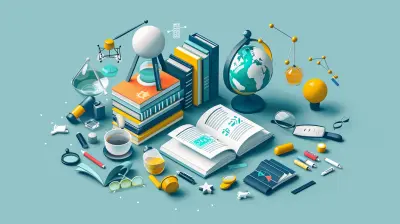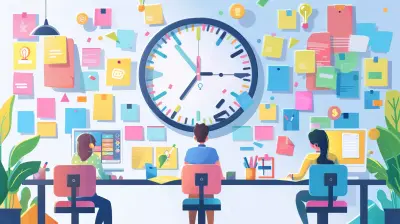22 March 2025
When we talk about improving education, there’s a buzz around new curriculum models, cutting-edge technology, and innovative teaching strategies. But let’s be real for a second—none of that matters if teachers aren’t equipped to deliver it. That’s where teacher professional development (often referred to as TPD) comes into play. After all, teachers are on the front lines of education reform. They’re the ones directly influencing the learning experiences of students. So, if we want real, sustainable change in the education system, we have to start with them.
In this article, we’re diving deep into why teacher professional development is vital for educational reform. If you’re an educator, administrator, or just someone passionate about improving education, you’ll want to stick around for this.

What Exactly Is Teacher Professional Development?
Before we get too far, let’s clarify what we mean by teacher professional development. In simple terms, it’s the process through which teachers acquire new skills, knowledge, and strategies to improve their teaching. This can include formal training sessions, workshops, peer collaboration, mentorship, and even self-directed learning.Think of it like this: Just as doctors need to keep up with the latest medical advancements, teachers need to stay on top of the latest educational practices. Whether it’s learning how to integrate technology into the classroom, adopting new teaching approaches, or understanding how to manage a diverse classroom, professional development helps teachers stay sharp.

The Role of Teachers in Educational Reform
Teachers are the linchpin of the education system. No matter how many well-intentioned reforms are introduced, they won’t make a dent unless teachers are on board and prepared to implement them. When we talk about education reform—whether it’s reducing achievement gaps, integrating technology, or shifting towards more student-centered learning—teachers are at the heart of it all.But here’s the kicker: Teachers can’t simply "figure things out" on their own. They need structured opportunities to learn and grow. Imagine asking a chef to prepare a gourmet meal without providing them any new ingredients or tools. It’s the same with teachers and educational reform. Professional development provides the "ingredients" and "tools" they need to adapt and embrace change.
Why Isn’t Traditional Training Enough?
You might be thinking, "Aren’t teachers already trained when they get their teaching degree?" Yes, they are. But here's the thing—education is constantly evolving. The best practices from five or even two years ago may no longer be relevant today.Here’s a bit of perspective: The world we live in moves fast. Technology advances, societal needs shift, and students’ learning preferences change. Teachers need ongoing professional development to keep up. It’s like updating the software on your phone—if you don’t do it regularly, you’ll miss out on important features (or in this case, effective teaching strategies).

The Benefits of Teacher Professional Development
So, what exactly does professional development do for teachers and, by extension, for students? Let’s break it down.1. Improved Teaching Skills
At its core, professional development helps teachers refine their teaching techniques. Whether it’s learning new ways to engage students, assessing their progress more effectively, or differentiating instruction for diverse learners, teachers walk away with practical tools they can use in the classroom. All of this translates to better learning experiences for students.2. Boosted Confidence
Imagine trying to implement a new teaching strategy that you’ve never seen in action and don’t fully understand. It would be stressful, right? Professional development gives teachers the confidence they need to adopt new methods without feeling overwhelmed. After all, it’s easier to adapt to change when you’ve had some practice and guidance.3. Increased Collaboration
Many teacher professional development programs emphasize collaboration. Teachers often work together to share ideas, provide feedback, and solve problems. This not only builds a sense of community among educators but also leads to better outcomes for students. When teachers collaborate, they can share what works and what doesn’t, helping each other grow.4. Keeping Up with Educational Trends
Educational trends come and go, but some are here to stay. From flipped classrooms to project-based learning and the integration of technology, teachers need to stay on top of these trends to remain effective. Professional development ensures that teachers are not only aware of these trends but also know how to implement them successfully.5. Better Student Outcomes
Ultimately, everything in education comes down to one thing: student success. When teachers engage in professional development, they’re better prepared to meet the needs of all students, leading to improved academic outcomes. Studies actually show a direct correlation between teacher development and student achievement. When teachers learn, students benefit.
Why Teacher Development is Key to Lasting Reform
Now that we know how valuable professional development is, let's talk about how it ties into educational reform.1. Bridging the Gap Between Policy and Practice
Education reforms often come from the top down—government bodies, policymakers, and educational leaders. However, there’s often a disconnect between what’s proposed and what actually happens in the classroom. Professional development acts as the bridge between policy and practice. It helps teachers understand how to implement new policies in a way that makes sense for their students and context.2. Sustainability of Reforms
Reforms can’t be flash-in-the-pan changes. For any real change to take root, it needs to be sustainable. Teacher professional development ensures that reforms aren’t just temporary fixes but long-lasting improvements. Think of it like planting a garden—you can’t just throw seeds in the ground and walk away. You need ongoing care, water, and attention. Similarly, professional development nurtures teachers so they can maintain and grow with the reforms.3. Adapting to Diverse Needs
Schools today are more diverse than ever. Students come from varied cultural, linguistic, and socioeconomic backgrounds. Educational reform often focuses on making education more inclusive and equitable. Teacher professional development is crucial for equipping educators with the tools to meet these diverse needs. Whether it's culturally responsive teaching or strategies for English language learners, professional development helps teachers adapt to the changing landscape of the classroom.4. Fostering Innovation
Reform is not just about fixing what’s broken; it’s about innovating for the future. Teachers who engage in professional development are more likely to experiment with new ideas, try out novel teaching techniques, and think outside the box. Professional development fosters a growth mindset, encouraging teachers to become lifelong learners themselves. In turn, this creates a culture of innovation in schools, which is essential for reform.5. Empowering Teachers
One of the biggest barriers to effective reform is teacher resistance. When educators feel like reforms are being forced upon them without their input or understanding, they’re less likely to embrace change. Professional development empowers teachers by involving them in the process of change. It gives them a voice and helps them see the value in new approaches. When teachers feel empowered, they’re more likely to be champions of reform rather than obstacles.Barriers to Effective Teacher Professional Development
While teacher professional development is clearly important, it’s not always easy to implement. There are several barriers that can get in the way:1. Time Constraints
Let’s face it—teachers are busy. Between lesson planning, grading, and managing a classroom, finding time for professional development can be tough. Schools and districts need to prioritize time for teachers to engage in meaningful professional development without adding to their already full plates.2. Lack of Resources
Professional development can be expensive, especially when it involves bringing in experts or sending teachers to conferences. Schools, particularly those in underfunded districts, may struggle to provide the necessary resources for effective professional development. This is why it’s important for educational leaders to advocate for funding and support for teacher development.3. One-Size-Fits-All Approaches
Not all professional development is created equal. Unfortunately, many programs take a one-size-fits-all approach, which doesn’t cater to the specific needs of individual teachers or schools. Effective professional development should be personalized and relevant to the unique challenges that teachers face in their classrooms.How to Make Teacher Professional Development More Effective
So, how can we overcome these barriers and ensure that professional development is truly effective? Here are a few key strategies:- Ongoing Support: Professional development shouldn’t be a one-time event. Teachers need ongoing support and follow-up to ensure that they can implement what they’ve learned.
- Collaboration: Encourage teachers to work together and learn from each other. Peer support and collaboration can make professional development more meaningful and impactful.
- Relevance: Make sure that professional development is relevant to the teachers’ needs and the specific challenges they face in their classrooms.
- Active Learning: Instead of passive, lecture-style training, professional development should involve active learning. Teachers should have opportunities to practice new skills and receive feedback.
Conclusion: The Path Forward
Teacher professional development isn’t just an optional extra—it’s a fundamental part of any successful educational reform. Teachers are the ones who turn reform ideas into classroom reality. Without the proper training, support, and resources, reforms are likely to fall flat. But when teachers are empowered through professional development, they become the driving force behind meaningful, sustainable change in education.So, if we really want to improve the education system, we need to invest in the people who make it all happen—our teachers. By prioritizing professional development, we’re not just improving teaching; we’re shaping the future of education itself.







Zephyris Willis
Empowered teachers drive effective reform and enhance student outcomes.
April 1, 2025 at 8:51 PM